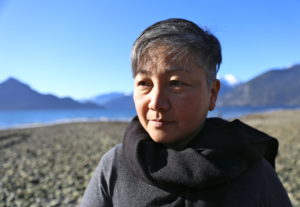
PRISM is pleased to present an excerpt from “And the Moon Spun Round Like a Top” by Hiromi Goto, upcoming in Issue 55.3. Hiromi gratefully acknowledges funding from the Canada Council for the Arts which supported the writing of this story.

Photo Credit: Sylvia McFadden’s Self Portrait Photo Booth.
Hiromi Goto is the author of many books for youth and adults. Her adult novel, Chorus of Mushrooms, was the recipient of the regional Commonwealth Writer’s Prize Award for best first book as well as the co-winner of the Japan-Canada Book Award. Her second adult novel, The Kappa Child, was awarded the James Tiptree Jr. Award. More recently, her young adult novel, Half World, won the 2010 Sunburst Award and the Carl Brandon Parallax Award. Darkest Light, a companion book to Half World, was published in 2012. Her first graphic novel, Shadow Life, artwork by Celine Loup, will be published in 2018 with First Second Books. She is a mentor at Simon Fraser University’s The Writer’s Studio and was also recently selected as one of the 2017 mentors of the Pierre Elliott Trudeau Foundation. Hiromi is currently working on a collection of essays and adult short stories. She gratefully lives on the unceded Salish lands of the Musqueam, Skwxwú7mesh, and Tsleil Waututh Peoples.
Check out Hiromi’s interview with PRISM Prose Editor Christopher Evans below the excerpt.
The hallway was empty. Forty minutes before official start time was early enough on a Monday to avoid running into anyone. Bernadette sighed with relief as she thrust a pair of trousers, a sweater, and a shirt into her locker. Atop the clothes, she placed a paper bag of spare underwear, tampons, and heavy flow nighttime napkins with wings. She would never be caught unprepared again.
She clanged the door shut and spun the lock with satisfaction. Now, to deal with the chair.
Before she left home, she’d forced a regular-sized tampon into her dry vagina. Walking made it scrape painfully against her tender flesh. Bernadette grimaced with discomfort as she opened the door to the large open office space.
There, beside her desk, over thirty-five minutes prior to the start of the official workday, sat Mathew.
Bernadette’s heart hammered inside her ears. Her breath grew shallow, her palms moist. I hate you…
Mathew turned around, as if he’d heard her, and gave her a little half-wave. She could see the red burn in his ears, even from twenty feet away.
Bernadette held her shoulders high. She would never have thought of Mathew as a cruel person. But to shame her in this way. She marched toward him in her flat work shoes. A thin smile on her lips. Well. So be it.
“You’re here early,” Bernadette said. “Preparing for the meeting this afternoon?”
“Morning,” Mathew said. Even seated he was almost eye-level to her standing. His eyes nervously slid off her face and she watched, distastefully, as his Adam’s apple bobbled. His next words came in a breathy whisper. “I-took-your-chair-to-supplies-and-brought-back-a-new-one.” He turned to his computer. The mechanical bong rang out as the old engine began to whir. He stared fixedly at the blue screen as the beach ball spun.
Bernadette whipped her head toward her desk.
It was true. The chair was new and the seat spotless. It also had arm rests. Her old one did not. She had chosen a chair without arm rests because her short height meant the rests were positioned incorrectly, and not, in any way, useful for her.
Relief, gratitude, and resentment roiled inside of her. Who asked Mathew to interfere in her affairs? By “helping” he was drawing more attention to the entire ignoble incident, adding a second layer of shame. And then placing her in a position of having to thank him for it all.
Why couldn’t people leave her alone? She left everyone else alone. Could no one perceive that she didn’t wish for them to bear witness to her life?
Bernadette sat in her new chair and faced her desktop computer. She turned it on, and watched the beach ball spin. She could feel heat emanating from Mathew’s head, and the weight of the silence between them.
CE: You’ve described “And the Moon Spun Round Like a Top” as a “feminist body-horror novelette,” and it really throws itself deeply into the confluence of horror and women’s bodies that has often marked your work—from breastfeeding in “Tales from the Breast” to same-sex reproduction in “Gold Star.” When and how did your interest in body-horror begin?
HG: As a young child I watched a great deal of adult television, and there wasn’t anyone to talk to/with about the content I’d seen. This seeded my imagination and psyche in particular ways. I was also reading adult novels by the time I was ten/eleven years old. Images-feelings of the abject, the uncanny were woven into my worldview in foundational ways. There was something in the horror genre that called to me—to the uneasiness that resides inside my humanity (everyone’s own monstrous), to the distorted echoes of the monstrous in the world I could see around me. In my family members, public school, church, society. I recently read an article by Aaron Orbey in The New Yorker which spoke about being drawn to horror: “that fictitious fears can help to soothe the real ones.” Yes, I thought.
When I started coming into my feminism in my twenties, and began seeing that gender normativity, misogyny, sexism, and racism were systems that were entrenched in culture to control, in particular, women’s and children’s bodies and lives, it was a kind of violent recognition. That’s one level of why I’m interested in body-horror. Another area that interests me is our own understanding and relationships (or conflict) with our own bodies. These relationships are complex and entwined with culture, society, taboo, etc. Bodies are complex and ever changing. We become ill or develop a chronic condition, we age, we feel pain, we eat, we shit, and we bleed. We procreate, we die. Our bodied lives are unfixed stories in a constant state of flux. The dissonance between culturally inflected narratives about our bodies (consider euphemisms and analogies) and our actual lived experiences in our bodies, is a rich arena for imaginative exploration and upsetting artificial notions of normativity. I’m writing body-horror from a woman’s perspective—well, my perspective, as a woman. For a very long time the horror genre has been dominated by men who have mostly used the portrayal of a woman’s fear (and her body) as ways to soothe their anxiety about controlling women. I.e. scare her, hurt her, kill her.
What piece of art scares you the most, in a positive way? Where do you draw the line between horror that’s pleasurable to absorb and horror that’s simply horrifying?
I’m no good at choosing a single thing of anything. Of course, in a bakery, I select one treat. But art? Impossible! I could not say which art piece scared me the most in a positive way because there are different kinds of fears. I would have to begin, first, by cataloguing the fears… Recent art of horror that have felt generative includes the films The Babadook, A Girl Walks Home Alone At Night, It Follows. Darksome stories like Kelly Link’s “The Specialist’s Hat” or going further back, older Japanese ghost stories like those found in Kwaidan: Stories and Studies of Strange Things, by Lafcadio Hearn. Like Eden Robinson, I was a big reader of Stephen King as a teen. Different kinds of stories inform us at different times in our lives. I used to watch any kind of horror film when I was younger quite blithely, but after I became a parent something fundamentally changed. Since then I cannot watch graphic physical violence done upon people, especially women and children. Especially if it’s sexual violence. I don’t wish to view gratuitous violence or see violence portrayed as mere spectacle—I can’t decode it as funny. I couldn’t watch Kill Bill for that reason. I don’t find these portrayals to be generative for me. It feels like an injury to watch them—something I need to protect is damaged by it.
Something I’ve noticed in your recent work, such as “And the Moon Spun Round Like a Top” or “Covalent Bond,” is characters’ fear that their privacy will be intruded upon or that they will be exposed in some way, which sometimes manifests as paranoia, deep personal embarrassment, and/or a desire to be left alone. Where does this fear and reaction come from?
I think there’s a great tension between wanting to be seen (recognized) and the desire to keep (some) things hidden. Helen’s desire for privacy, in “Covalent Bond,” is a result of deep family dysfunction. With Bernadette in “And the Moon Spun Round Like a Top,” however, I wanted to really delve into the exploration of a character who was growing more intensely private even as the world around becomes increasingly “share-sy.” There’s a particular time in early childhood development when children begin to understand that people are looking at them. I can remember one of my children, in particular, often exclaiming, “Don’t look at me!” There’re echoes of that intense dislike to be seen, I think, in most of us in some way. In Bernadette’s case, it’s been pushed as far as I could take it.
You spoke recently about the idea of “nourishment” in writing—both seeking material that nourishes you in some way as a reader, and also writing about physical and emotional nourishment in your own work. Can you expand on why that’s important to you?
We need food and water to keep us alive. They enter our bodies and become part of our bodies. So it is with stories, art, what we see, interact with, witness. Ideas. Stories enter our bodies, too. They actually cause chemical responses inside us; our body reacts with disgust, fear, joy, love. Endorphins, adrenalin, elevated heart rate. These are all measurable shifts in the body, and cells remember trauma, can pass it onto to the next generation. I’m no Pollyanna. Believe me. But there’s so much bad shit in the human world that assails the spirit, that seeks to destroy and control and conquer. It’s important to me that what I fold back into cultural production is something that does not destroy, but leaves open some space for growth or hope or change. That said, “Covalent Bond” was pretty bleak… I do try to braid into these darker stories glints of humour.
The first time you and I met, we spoke almost exclusively about our mutual love of giant salamanders, and you’ve consistently made references to animals and the natural world in your stories. “And the Moon Spun Round Like a Top” also contains, er, “creatures.” Are the “creatures” in this piece a continuation of that interest? Or a subversion of it?
I have a life-long fascination, love, and respect for flora and fauna. The creatures in this tale are a fantastic extension of our inherent creatureness and the idea that there is so much that we do not know… Of our selves, our bodies, and the ever-evolving aspects of life. We’re such beautiful monsters.
Christopher Evans is the Prose Editor of PRISM international. His fiction, non-fiction, and poetry have appeared in The New Quarterly, EVENT, Grain, Going Down Swinging, Isthmus, Joyland, and other fine publications.